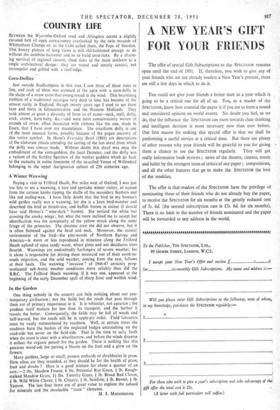A Winter Waxwing Paying a visit to Frilford Heath, five
miles west of Oxford, I was just too-late to see a waxwing, a rare and sporadic winter visitor, so named from the curious knobs tipping the shafts of the secondary feathers and like red sealing-wax. I have little doubt that the bird in my hostess's wild garden really was a waxwing, for she is a keen bird-watcher and described the bird as thrush-size, and buffish brown in colour (I should have said Homer's " wine-dark " brown). She noticed the white bar crossing the smoky wings ; but what the more inclined me to accept her identification was the conspicutty of the yellow streak along the outer fringe of the primaries. The chestnut crest she did not observe, but it is often flattened against the head and neck. Moreover, the natural environment of the bird—the pine-woods of Northern Europe and America—is more or less reproduced in minature along the Frilford Heath upland of open sandy waste, where pines and not deciduous trees flourish. Waxwings are undoubtedly harbingers of severe weather, for it alone is responsible for driving them westward out of their north-to- south migration, and the cold weather, coming from the east, follows at their heels. The waxwing "invasion" of 1946-47 certainly prog- nosticated sub-Arctic weather conditions more reliably than did the B.B.C. The Frilford Heath waxwing, if it was one, appeared at the beginning of the early December spell of sharp frost and wolfish wind.






























 Previous page
Previous page